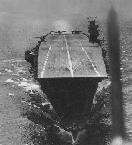entemedor
Posts: 65
Joined: 6/14/2002
From: Barcelona (Spain)
Status: offline

|
Night is upon us.
I promised the Emperor six months of victories. For six months the rising sun shone in the Pacific. Now, night is covering us.
Operation 'K' went as expected. We lost SHOHO in the Coral Sea, in May, but sank one enemy carrier and left another burning. Our troops landed in Buna, Tulagi and Gilli Gilli. Only Port Moresby refused to yield, but our land-based bombers kept gnawing at it. JUNYO joined our carrier ranks; she, together with our two crane-birds, SHOKAKU and ZUIKAKU, ranged far and wide the ocean, sinking transports and minor ships. Our cruisers pounded Lunga unopposed. The enemy was nowhere to be seen. Some of my officers began to say that the Americans had no spirit, that they were afraid of challenging our fleets. I knew better than that, but the enthusiam of my men was contagious. Perhaps they were right, after all. How rash, how blind I was!
All this changed on the 13th of June. We had great expectations for that day: our main carrier force was approaching Port Moresby, and behind it sailed the invasion force that would put a end to that thorn on our side. Simultaneously, and for the first time, a battleship, mighty KIRISHIMA, was joining the force bombarding the enemy troops at Lunga. At midnight, our ships clashed off Tassafaronga with an enemy force: heavy cruisers and destroyers. There could be no doubt of the outcome. But doubt there was, when the first reports talked of enemy ships closing to point-blank range, of ships on fire on both sides. Then a disturbing message: cruiser MAYA had exploded, a destroyer was lost too. And at dawn the shocking news: big KIRISHIMA, hit by a rain of shells, was in the bottom of Tassafaronga, with her commander and most of her crew. The confirmed destruction of two enemy cruisers was small consolation for this sad blow.
With no time to recover, more news reached my flagship:
while our carrier planes destroyed an Australian convoy heading for Moresby, the enemy land-planes began arriving over our carrier force.
My operations officer was confident; surely that mixed bag of Hudsons, B-25s and P-39s would be no match for our CAP fighters. The following reports were increasingly surprising; they even talked of fighter-bomber pilots sacrificing themselves like Samurais, making almost suicidal strafing runs against our carriers. And suddenly, there was Genda, telling me in a sorrow voice that ZUIKAKU was reported hit and on fire! I heard in disbelief that a high-flying B-25 had done it; the flight-deck was out of use, and the carrier's planes returning from his strike had to be diverted to nearby airfields at Buna and Gilli Gilli. My worries deepened when I heard that Vice-Admiral Yamaguchi was taking a decision I considered wrong: ZUIKAKU was to withdraw under escort of three destroyers, while SHOKAKU carried on her appointed mission and neutralized Port Moresby airfield. I ordered that land-based fighters from the Tainan air group, deployed at Buna, provided ZUIKAKU with long-range CAP for her trek northwards. Hardly had these orders been acknowledged, that further shocking news came to us: an enemy carrier had been located to the East. The SHOKAKU's crew worked frantically to launch an strike against her; and soon after our own attack wave had departed, the enemy dive-bombers came screaming upon SHOKAKU. Five times Yamaguchi's flagship trembled under the exploding bombs; in a few minutes the ship was enveloped in flames and clearly doomed. SHOKAKU's own strike did find the enemy carrier, identified as the HORNET, and we followed with anxiety our pilots attack by relayed messages. One by one our torpedo-bombers were shot-down by the enemy CAP, and despite their valour and severe losses, our dive-bombers failed to obtain any hits on the enemy carrier. With tears in my eyes I heard them report that they were returning to SHOKAKU; full well I knew there was no deck where they could settle now. For SHOKAKU had already foundered, and Yamaguchi with her. Just a handful of our returning airmen were rescued by destroyers after ditching.
And the woes of that long day had no end. The Port Moresby bombers had located our invasion force now, and began landing bombs on our loaded transports. It was not long afterwards that the final blow came: enemy carrier planes found the crippled ZUIKAKU steaming North. At that very moment, just one plane from the Tainan air group, piloted by Lt Kawamura, was on CAP over the carrier; he valiantly attacked alone, flaming one after another three enemy torpedo-bombers, but the odds were impossible. Dive-bombs hit ZUIKAKU time after time, and soon she was ablaze from end to end.
With trembling voice I ordered ZUIKAKU to be scuttled, and all our forces to withdraw towards Rabaul. In the bridge, my officers wept as they counted the sad remnants of our invasion and carrier forces. How could we explain that to the Emperor?, asked Genda in a broken voice. Leave this to me, I answered. It is my duty to apologise to the Emperor.
June 13, 1942. Night is upon us...
|
 Printable Version
Printable Version






 New Messages
New Messages No New Messages
No New Messages Hot Topic w/ New Messages
Hot Topic w/ New Messages Hot Topic w/o New Messages
Hot Topic w/o New Messages Locked w/ New Messages
Locked w/ New Messages Locked w/o New Messages
Locked w/o New Messages Post New Thread
Post New Thread